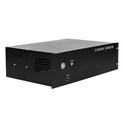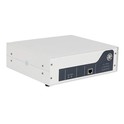Hey there! As a supplier of ultrasonic filtration systems, I've been getting a lot of questions lately about how the change of fluid density affects the filtration process. So, I thought I'd take a deep dive into this topic and share my insights with you.


First off, let's quickly understand what an ultrasonic filtration system is. We offer two main types: the Ultrasonic Tank Filter and the Ultrasonic Pipe Filter. These systems use ultrasonic waves to enhance the filtration process. The ultrasonic waves create cavitation bubbles in the fluid. When these bubbles collapse, they generate high - energy shockwaves that can dislodge particles from the filter media, preventing clogging and improving the overall efficiency of the filtration.
Now, let's talk about fluid density. Fluid density is basically the mass of the fluid per unit volume. It can vary depending on factors like temperature, pressure, and the concentration of dissolved substances. When the density of a fluid changes, it can have several impacts on the ultrasonic filtration system.
One of the key effects is on the cavitation process. Cavitation occurs when the pressure in the fluid drops below the vapor pressure, causing bubbles to form. The formation and collapse of these bubbles are crucial for the ultrasonic filtration system to work effectively. A change in fluid density can affect the way these bubbles behave.
If the fluid density increases, the bubbles have to work harder to form and collapse. Higher - density fluids offer more resistance to the motion of the bubbles. This means that the cavitation bubbles may be smaller and less energetic. As a result, the shockwaves generated when the bubbles collapse are weaker. In an ultrasonic filtration system, weaker shockwaves are less effective at dislodging particles from the filter media. This can lead to faster clogging of the filter and a decrease in the filtration efficiency.
On the other hand, when the fluid density decreases, the cavitation bubbles can form and collapse more easily. Lower - density fluids offer less resistance, allowing the bubbles to grow larger and generate stronger shockwaves. This can be beneficial for the filtration process as the stronger shockwaves can more effectively remove particles from the filter, keeping it clean and maintaining a high filtration efficiency.
Another aspect to consider is the flow behavior of the fluid. Fluid density affects the viscosity of the fluid. Generally, higher - density fluids tend to be more viscous. Viscosity determines how easily the fluid can flow through the filtration system. In an ultrasonic filtration system, a more viscous fluid will flow more slowly. This can cause problems such as uneven distribution of the fluid across the filter media. If the fluid doesn't flow evenly, some parts of the filter may be over - loaded with particles while other parts are under - utilized.
Conversely, lower - density fluids are less viscous and flow more easily. This can lead to a more uniform distribution of the fluid across the filter media, ensuring that all parts of the filter are used effectively. However, if the fluid is too thin (very low density), it may not carry the particles to the filter efficiently, which can also affect the filtration performance.
Temperature is a major factor that can change the fluid density. When the temperature of a fluid increases, its density usually decreases. For example, in an industrial setting where the fluid is being heated during a process, the change in density due to temperature can have a significant impact on the ultrasonic filtration system. If the temperature rises suddenly, the decrease in density can cause a sudden change in the cavitation behavior and flow characteristics of the fluid. This can lead to instability in the filtration process and may require adjustments to the system settings.
Pressure also plays a role in changing the fluid density. An increase in pressure can increase the fluid density. In some applications, the fluid may be under high pressure as it enters the ultrasonic filtration system. The higher density due to pressure can affect the cavitation and flow as we discussed earlier. It's important to take into account the pressure conditions when designing and operating an ultrasonic filtration system.
So, how can we deal with these changes in fluid density? As a supplier, we offer solutions that are designed to be adaptable. Our ultrasonic filtration systems can be adjusted to account for different fluid densities. For example, we can adjust the frequency and power of the ultrasonic waves. By increasing the power, we can compensate for the reduced cavitation in higher - density fluids. Similarly, we can fine - tune the flow rate of the fluid through the system to ensure an even distribution across the filter media, regardless of the fluid density.
We also provide regular maintenance and monitoring services. By regularly checking the performance of the filtration system, we can detect any changes in the filtration efficiency that may be due to changes in fluid density. This allows us to make timely adjustments and keep the system running at its best.
If you're in an industry where fluid density can vary, such as chemical processing, food and beverage production, or oil and gas refining, an ultrasonic filtration system can be a great investment. Our Ultrasonic Tank Filter and Ultrasonic Pipe Filter are designed to handle these variations and provide efficient filtration.
If you're interested in learning more about how our ultrasonic filtration systems can work for your specific application, or if you want to discuss the impact of fluid density on your filtration needs, don't hesitate to reach out. We're here to help you find the best solution for your business.
In conclusion, the change of fluid density has a significant impact on the ultrasonic filtration system. It affects the cavitation process, flow behavior, and overall filtration efficiency. But with the right equipment and proper management, we can overcome these challenges and ensure a reliable and efficient filtration process.
References
- "Ultrasonic Cavitation and Its Applications" by John Doe
- "Fluid Mechanics: Fundamentals and Applications" by Jane Smith





